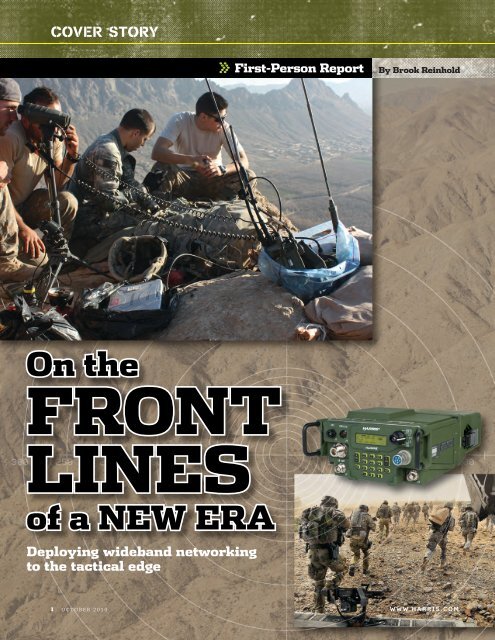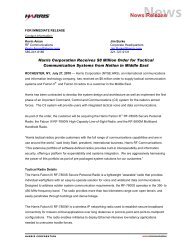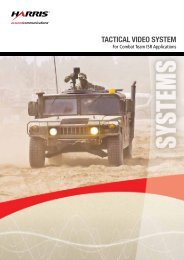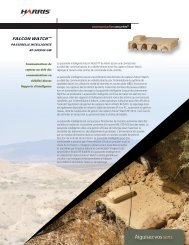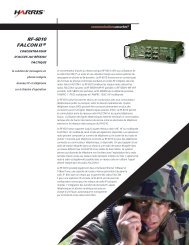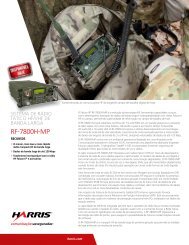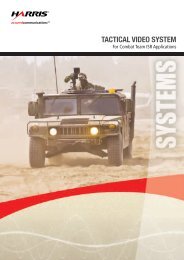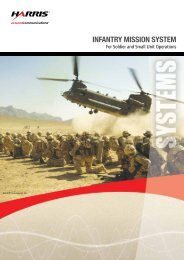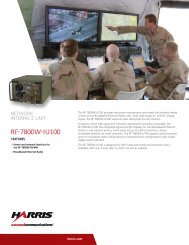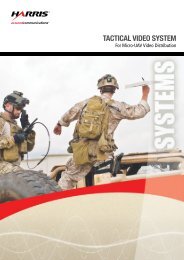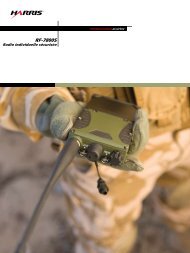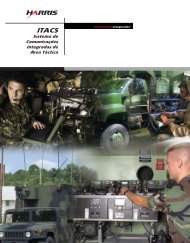On the front lines - Harris Corporation
On the front lines - Harris Corporation
On the front lines - Harris Corporation
Create successful ePaper yourself
Turn your PDF publications into a flip-book with our unique Google optimized e-Paper software.
COVER STORY<br />
» First-Person Report<br />
By Brook Reinhold<br />
<strong>On</strong> <strong>the</strong><br />
FRONT<br />
LINES<br />
of a NEW ERA<br />
Deploying wideband networking<br />
to <strong>the</strong> tactical edge<br />
1 o c t o b e r 2 0 1 0 W W W . H A R R I S . C O M
ook Reinhold, an applications<br />
engineer for <strong>Harris</strong> RF<br />
Communications, is a former<br />
communications chief for <strong>the</strong> U.S.<br />
Army’s 82nd Airborne Division.<br />
Reinhold and two colleagues—<br />
Will Fletcher and Mike Gonzalez—<br />
recently spent several months<br />
working with an Army Brigade<br />
Combat Team in Afghanistan to<br />
deploy <strong>the</strong> first-ever battalion-level<br />
mobile wideband radio network for<br />
<strong>front</strong>-line personnel. This network<br />
consists primarily of <strong>Harris</strong><br />
Falcon III® AN/PRC-117G tactical<br />
radios and meshes with larger<br />
networks at brigade and above.<br />
This is Brook’s personal account of<br />
bringing this vital new capability to<br />
currently deployed forces.<br />
A lifetime ago I was trained to<br />
carry telephone wire to provide<br />
communications for commanders on<br />
<strong>the</strong> battlefield. No joke. We would strap<br />
a mile of wire in cloth reels to boards on<br />
our backs and move with <strong>the</strong><br />
commander—like radio operators today,<br />
only with a telephone. When <strong>the</strong><br />
commander wanted to talk, we cranked<br />
<strong>the</strong> phone and <strong>the</strong> switchboard would<br />
answer, patching him to <strong>the</strong> distant<br />
station. We would compete to be <strong>the</strong><br />
first person on <strong>the</strong> team to carry for <strong>the</strong><br />
commander because once <strong>the</strong> wire was<br />
unwound, our load was much lighter for<br />
<strong>the</strong> rest of <strong>the</strong> movement.<br />
I also remember <strong>the</strong> day <strong>the</strong> Army<br />
delivered our first SATCOM radio. Our<br />
battalion combat signal team sat on <strong>the</strong><br />
<strong>front</strong> stoop of <strong>the</strong> barracks in Fairbanks,<br />
Alaska, and trained with <strong>the</strong> radio. We<br />
set up <strong>the</strong> antenna and conducted a<br />
“splash” test to make sure we were<br />
aimed at <strong>the</strong> proper satellite.<br />
And so it was, with all preliminary<br />
checks complete, that this battalion of<br />
soldiers—operating in <strong>the</strong> Arghandab<br />
Valley, one of <strong>the</strong> most dangerous places<br />
in <strong>the</strong> world—began communicating via<br />
a mobile, wireless IP network.<br />
Anticipating failure, we attempted a<br />
radio check to ano<strong>the</strong>r communicator in<br />
Anchorage. When he answered, we<br />
stood <strong>the</strong>re with stupid grins on our<br />
faces, amazed that we could talk so far<br />
so easily—in excess of 200 miles on a<br />
radio we could carry on our backs. The<br />
voice quality was delayed and horrible<br />
compared to today’s radios. But in that<br />
one robotic sounding voice check, our<br />
concept of tactical communications had<br />
changed forever.<br />
Those moments came back to me<br />
again last November, in one of <strong>the</strong> most<br />
notorious places in Afghanistan, when I<br />
had <strong>the</strong> opportunity to work with a<br />
battalion of paratroopers from <strong>the</strong> 82nd<br />
Airborne Division in moving military<br />
communications into ano<strong>the</strong>r new era.<br />
I was leading a <strong>Harris</strong> team assisting<br />
<strong>the</strong> battalion communicators in<br />
standing up <strong>the</strong> first wideband tactical<br />
communications radio network for <strong>the</strong>ir<br />
soldiers, using <strong>the</strong> first NSA-certified and<br />
JTRS SCA-certified Type-1 wideband<br />
radio in <strong>the</strong> world—<strong>the</strong> <strong>Harris</strong> AN/<br />
PRC-117G. Their vision was to deploy<br />
<strong>the</strong>se radios to extend <strong>the</strong> SIPRNet to<br />
remote commanders and platoon<br />
leaders at fixed sites and on <strong>the</strong> move<br />
across <strong>the</strong> battalion’s maneuver area.<br />
The day <strong>the</strong> wideband network went<br />
live, <strong>the</strong> Non-Commissioned Officer in<br />
Charge (NCOIC)—using a traditional<br />
Communication Exercise (COMMEX)<br />
checklist to track progress—directed his<br />
soldiers to turn <strong>the</strong>ir AN/PRC-117G<br />
radios to cipher text (CT). He watched<br />
Photo credit: U.S. Army cPt ryan Kenny, task Force Fury.<br />
T A C T I C A L C O M M S J O U R N A L o c t o b e r 2 0 1 0 2
Brook Reinhold of <strong>Harris</strong>, right, advises<br />
U.S. Army soldier on <strong>the</strong> AN/PRC-117G.<br />
carefully as <strong>the</strong> radios in a matter of<br />
seconds powered up and <strong>the</strong> Adaptive<br />
Networking Wideband Waveform<br />
(ANW2) network formed. Each radio<br />
listened for o<strong>the</strong>r radios and in a minute<br />
<strong>the</strong>y were all accounted for and located<br />
on one network.<br />
The NCOIC picked up <strong>the</strong> handset<br />
and made a voice call using <strong>the</strong><br />
dedicated voice-hopping circuit in <strong>the</strong><br />
radio. Each radio responded and was<br />
checked off <strong>the</strong> list.<br />
The soldiers were directed to begin<br />
testing <strong>the</strong> data capability of <strong>the</strong> radio.<br />
The COMMEX FRAGO called for checks<br />
to be completed using voice, mIRC chat,<br />
Web-based applications, position<br />
reporting, and file transfer. Each station<br />
logged into a mIRC chat server and into<br />
<strong>the</strong> Battalion Operations chat room—<br />
in each case, successfully passing chat<br />
traffic. The next test was for Web<br />
applications. Each station systematically<br />
used Internet Explorer to access<br />
Webmail, AKO-S, <strong>the</strong> battalion TIGRnet<br />
server, and <strong>the</strong> Brigade Combat Team<br />
Web portal. All stations successfully<br />
confirmed access to <strong>the</strong>se missioncritical<br />
information sites. As <strong>the</strong><br />
COMMEX progressed, blue icons<br />
appeared on <strong>the</strong> FalconView maps.<br />
Each radio’s built-in GPS tracked onto<br />
<strong>the</strong> satellites and automatically reported<br />
<strong>the</strong> radio's position through <strong>the</strong><br />
network. The icons had a “G” as well as a<br />
numerical designator showing <strong>the</strong><br />
identity of <strong>the</strong> unit and that <strong>the</strong> track<br />
was from a 117G.<br />
The last check was photo and file<br />
transfer using <strong>Harris</strong> <strong>Corporation</strong>’s chat<br />
software, RF-6705 TACHAT IP. Each<br />
station was directed to send a photo and<br />
a Microsoft PowerPoint document to<br />
<strong>the</strong> NCOIC to show <strong>the</strong> ability to transfer<br />
file information between nodes and to<br />
higher headquarters using <strong>the</strong> IP network.<br />
I’ve worked with <strong>the</strong> soldiers of this<br />
3 o c t o b e r 2 0 1 0 W W W . H A R R I S . C O M
unit for over a year, and o<strong>the</strong>rs from<br />
across <strong>the</strong> Army on a regular basis.<br />
Watching <strong>the</strong> aggressive way <strong>the</strong>y move<br />
through <strong>the</strong>ir tasks, and shrug off<br />
hardships day after day, I sometimes<br />
forget <strong>the</strong>y are so young. As this new<br />
technology went live, I was quickly<br />
reminded that under <strong>the</strong> crust of <strong>the</strong>ir<br />
mature professionalism was a bunch of<br />
young guys. Pictures arriving from <strong>the</strong><br />
117G outstations showed unit soldiers<br />
displaying various universal gestures of<br />
The Falcon III AN/PRC-117G is <strong>the</strong> first<br />
JTRS SCA-certified, NSA Type-1 certified<br />
wideband radio. The U.S. Army is deploying<br />
<strong>the</strong> radio to Brigade Combat Teams across<br />
Afghanistan to deliver wideband networking<br />
to forces at <strong>the</strong> <strong>front</strong> of <strong>the</strong> fight.<br />
camaraderie. The NCO checked off<br />
stations as <strong>the</strong> pictures arrived—adding<br />
<strong>the</strong> appropriate derogatory assessment<br />
of each.<br />
And so it was, with all preliminary<br />
checks complete, that this battalion of<br />
soldiers—operating in <strong>the</strong> Arghandab<br />
Valley, one of <strong>the</strong> most dangerous places<br />
in <strong>the</strong> world—began communicating<br />
via a mobile, wireless IP network.<br />
Conversation hushed as <strong>the</strong> soldiers<br />
watched <strong>the</strong> network chat rooms fill<br />
with convoy reports, logistics requests,<br />
a MEDEVAC from a sister battalion near<br />
<strong>the</strong> Afghanistan/Turkmenistan border.<br />
This was <strong>the</strong> tactical communication<br />
chatter of a Brigade Combat Team at<br />
war, <strong>the</strong> message traffic controlling <strong>the</strong><br />
day-to-day actions of over 5,000<br />
paratroopers fighting in an area half <strong>the</strong><br />
size of Texas. The soldiers understood<br />
<strong>the</strong> seriousness of <strong>the</strong> traffic, and <strong>the</strong>re<br />
was no doubt that <strong>the</strong>y knew what <strong>the</strong>y<br />
were accomplishing. You could sense<br />
this in <strong>the</strong>ir silence and <strong>the</strong> changes<br />
in <strong>the</strong>ir body language. Just as my<br />
experience with a SATCOM call 25<br />
years ago changed <strong>the</strong> way five combat<br />
signal soldiers in Alaska viewed<br />
communications, <strong>the</strong>se soldiers realized<br />
that <strong>the</strong>y were entering a new era. More<br />
than that, <strong>the</strong>y realized that <strong>the</strong>y were<br />
<strong>the</strong>re first. Their efforts had opened <strong>the</strong><br />
door for mobile wideband networks on<br />
<strong>the</strong> battlefield.<br />
Since <strong>the</strong> first wideband network was<br />
installed by <strong>the</strong> communicators of <strong>the</strong><br />
2nd Battalion of <strong>the</strong> 508th Infantry<br />
Regiment (2/508), at least 17 more<br />
ANW2 SIPR networks are operational in<br />
Afghanistan. Units from <strong>the</strong> 101st ABN<br />
Division, <strong>the</strong> Stryker Brigade from Ft.<br />
Lewis, and <strong>the</strong> 4th Infantry Division<br />
have followed this success by building<br />
networks to support combat operations<br />
across Afghanistan. At this writing, <strong>the</strong><br />
Army is in <strong>the</strong> early stages of deploying<br />
wideband AN/PRC-117G radios to o<strong>the</strong>r<br />
Brigade Combat Teams in Afghanistan.<br />
The goal is to flatten <strong>the</strong> information<br />
architecture, allowing leaders closest to<br />
<strong>the</strong> fight access to <strong>the</strong> tactical Internet.<br />
Wideband networking requires a<br />
shift of thinking: namely, <strong>the</strong>se radios<br />
operate beyond <strong>the</strong> normal limitations<br />
of terrestrial line-of-sight by relaying<br />
voice and data traffic from node to<br />
node, according to mission plans. So<br />
<strong>the</strong> traditional job descriptions of a<br />
communication MOS 25B and 25U have<br />
to expand, learning a little of <strong>the</strong> o<strong>the</strong>r’s<br />
job skill. Soldiers focused on IP<br />
networking had to learn something<br />
about radios—to understand how<br />
radios carry data—while radio operators<br />
have to learn something about IP<br />
networks to enable troubleshooting to<br />
<strong>the</strong> end user. The 82nd soldiers did all<br />
this in <strong>the</strong> middle of a very live fight in<br />
<strong>the</strong> harsh conditions of Afghanistan.<br />
My personal communication<br />
experience started in <strong>the</strong> mid 1980s,<br />
where primary communication was<br />
achieved using field telephone wire.<br />
Now, I routinely work with soldiers who<br />
have <strong>the</strong> capability to monitor multiple<br />
active chat rooms from a small laptop in<br />
<strong>the</strong>ir M-ATV or send immediate reports<br />
or biometrics updates anywhere in <strong>the</strong><br />
world from a small radio on <strong>the</strong>ir back. I<br />
just have to show <strong>the</strong>m <strong>the</strong> capability<br />
and stand back and watch as <strong>the</strong><br />
computer-savvy soldiers of this<br />
generation grasp <strong>the</strong> power of <strong>the</strong><br />
tactical network and push <strong>the</strong> new<br />
capability into <strong>the</strong> future. •<br />
T A C T I C A L C O M M S J O U R N A L o c t o b e r 2 0 1 0 4


